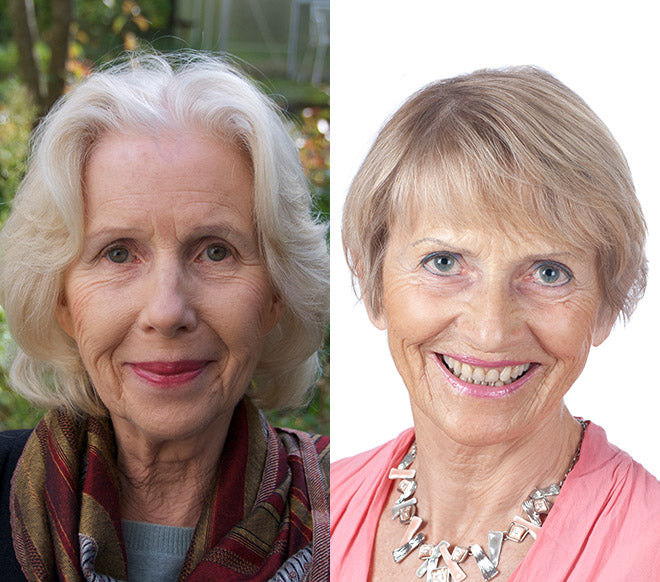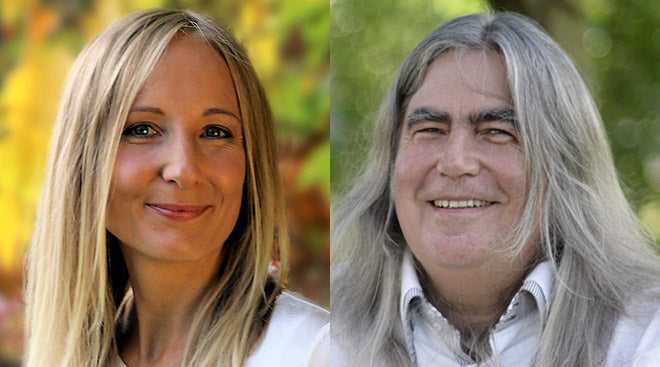
Interview with Prof. Gerhard and Dr. Rias-Bucher: “Our myoma diet is based on plant-based foods”
Interview with Prof. Gerhard and Dr. Rias-Bucher: “Our myoma diet is based on plant-based foods”
"Natural healing methods have their place when the patient is prepared to help reduce the size of the myomas by changing her lifestyle. Then she can use an optimized diet (...) to ensure that less estrogen circulates in her body and more progesterone is produced." In an interview , gynecologist Prof. Dr. Ingrid Gerhard and nutrition expert Dr. Barbara Rias-Bucher , both authors of the guidebook "Healing Myomas Yourself," explain what myomas are, how they arise, what treatment options there are - and what an ideal "myoma shrinking treatment" should look like.
Myomas are the most common benign tumors in women between puberty and menopause. What causes them and what are the symptoms?
Prof. Gerhard: Little is known about the actual cause of myomas. There are certainly genetic causes, as they can occur more frequently in some families and are more common in African women than in European women. The fact that myomas develop during the sexually mature phase of a woman suggests that female hormones play a role. An imbalance between estrogen and progesterone can usually be seen. This is most clearly seen in the myoma cell itself, which has more estrogen receptors than a healthy cell. Other growth factors are known, such as those that occur in cases of obesity and impaired sugar metabolism.
The most common symptoms are bleeding disorders, often associated with pain. Depending on the number, location and size of the myomas, the woman may complain of bladder pressure with a need to urinate, back pain, difficulty defecating, bloating and discomfort during sexual intercourse. Miscarriages or an unfulfilled desire to have children can also be related to myomas.
The risk of cancerous degeneration is practically non-existent with myomas, but you still recommend regular check-ups to avoid secondary diseases. What are these and when is surgery recommended?
Prof. Gerhard: The fibroids should not be allowed to grow too large, as this makes the surgical options more difficult. The fibroids can grow at a different rate in every woman and it is difficult to predict this; this is why regular check-ups are very important. It is particularly important for women who want to have children to take action against the fibroids at an early stage. Although fibroids are not necessarily an obstacle to pregnancy, depending on their size and location they can lead to reduced fertility and increased risks during pregnancy. If fibroids cause bleeding disorders, the iron level should be checked regularly - even if iron is taken - to ensure that it does not drop too far.
Surgery is always recommended when the suffering is severe, the function of the surrounding organs is impaired and it is expected that growth will not stop before menopause.
What conventional therapies are available to treat fibroids, and how can natural healing methods be used to prevent and combat them?
Prof. Gerhard: First of all, there is hormonal therapy: the imbalance between too much estrogen and too little progesterone can be balanced out by administering gestagens. Long-term use of the pill can also slow down growth. Many women can also get their bleeding disorders under control with the hormonal coil. Great hopes were placed on ulipristal acetate (Esmya), a selective progesterone receptor modulator. This drug was initially only used before a planned operation, but was later approved for long-term therapy. In some women, it led to a reduction in the size of the fibroids and a reduction in bleeding. However, no new patients are currently being treated with this method because of the risk of liver damage. If hormonal therapies do not help, there are many different surgical methods to reduce or remove individual fibroids or the entire uterus.
Natural healing methods have their place when the patient is prepared to help reduce the size of the fibroids by changing her lifestyle. Then she can ensure that less estrogen circulates in her body and more progesterone is produced through an optimized diet, as explained below. By normalizing sugar metabolism, she can slow down the harmful growth factors herself. Herbal remedies that influence the hormone metabolism and bleeding in women are also helpful in this case. A relatively new discovery is that high doses of green tea extract (epigallocatechin) can be used to slow down the growth of fibroids. The Charité in Berlin is currently recruiting patients with fibroids for a study to test their effectiveness.
Of course, traditional Chinese medicine can also be successful. At the women's clinic in Heidelberg, we have also seen homeopathic treatments result in shrinkage of myomas when they had recently developed and were still less than 4 cm in size.
Natural healing methods also have their natural limitations: When it comes to large, long-standing, partially calcified myomas, shrinking them becomes difficult or even impossible – but the growth of new myomas can be limited in any case.
Myomas are caused by too much estrogen and too little progesterone. Do you have to resort to pills and nutritional supplements, or can natural products also balance out the hormonal imbalance?
Dr. Rias-Bucher: The imbalance between the excess estrogen and the lack of progesterone can be alleviated and even remedied by a range of herbal remedies and foods. These include women's herbs such as yarrow and very common foods such as pulses, whole grains, vegetables, fruit, linseed or olives. It has been known for years that vegetarians and women in East Asia hardly suffer from hormone-related female complaints. The cause is phytoestrogens, bioactive substances from the large group of polyphenols, which have a similar structure to our estrogens. They have a positive effect on the hormonal balance via complex endogenous mechanisms and - unlike our own hormones - do not stimulate the growth of myomas.
Especially in the relatively early stages, there is a chance of slowing down the growth of myomas through a certain lifestyle and appropriate diet. Is this a new idea, or are there already tried and tested recipes that will be familiar to the women affected?
Dr. Rias-Bucher: We recommend a wholesome, nutrient-rich diet with a variety of foods and a high nutrient density. This nutritional concept was developed in the 1980s at the University of Giessen and by the DGE (German Nutrition Society). Since then, our eating habits have changed and in many ways adapted to this whole-food principle. Many people save on animal products and prefer unadulterated, natural foods from local cultivation, buy fresh vegetables, salad and fruit according to seasonal availability and choose organic products as often as possible.
The right diet is an essential part of self-help for myomas. Which foods should you avoid and which should be on the menu for the "myoma shrinking diet"?
Dr. Rias-Bucher: Our myoma diet, like the modern mixed diet, is based on plant-based foods. There are two reasons for this: firstly, myomas are not stimulated by plant-based foods. Secondly, they cover a whole spectrum of substances that can have both a preventive and healing effect on myomas: bioactive substances such as phytoestrogens, antioxidants and prebiotics, as well as plant proteins and fats and predominantly alkaline foods. So prefer unadulterated, natural, fresh and seasonal foods from local cultivation and eat whole grain rather than white flour products. Eggs, meat, fish and ham or dairy products and sweets are not forbidden on the myoma diet, but should only be consumed in small quantities once or twice a week. And I mean that literally: enjoying them now and then is fine, but just eating them to no end is not a good idea!
Many sufferers are used to fast food or home cooking with plenty of animal products such as meat, sausage, ham, eggs and cheese. What is the best way to switch to a wholesome and plant-based diet?
Dr. Rias-Bucher: Go about it carefully, because your body needs to get used to the new food: Start with at least one vegetarian or vegan dish a day, which you choose from the chapters in our book - whether in the morning, at lunchtime or in the evening, it doesn't matter at first. Then increase the amount every week until you are eating a completely vegetarian diet three days a week. At the beginning of the myoma shrinking diet, only eat mini portions of raw food. Diced tomatoes, very finely sliced cucumbers, grated carrots and zucchini, and thinly sliced fennel are good for you, because all of these vegetables provide fiber but don't cause bloating.
In addition to changing your diet, you particularly recommend phytotherapy for any myoma treatment. Which herbal remedies are useful here and where can you get them?
Dr. Rias-Bucher: Here, too, we have a whole spectrum at our disposal. Firstly, we choose phytopharmaceuticals that balance hormone levels: yarrow and shepherd's purse contain hormone-like substances that reduce or completely prevent the growth of myomas. These phytoestrogens occupy some of the receptors that estrogen normally attaches to. This tells the pituitary gland that hormone levels are in balance. Secondly, we use plants that contain tannins, such as lady's mantle, tormentil and burnet, which prevent or even stop bleeding so that the secondary disease of anemia does not occur. Thirdly, salicylic acid compounds in willow bark and meadowsweet, as well as phenolic acids and flavonoids in nettles, are effective painkillers; coumarins in cinquefoil, and bitter substances in lady's mantle and yarrow help with abdominal cramps. You can get all herbal remedies at the pharmacy, and in our book you will find recipes for tea blends and tips for specific preparations.
Book tip:
Prof. Dr. Ingrid Gerhard & Dr. Barbara Rias-Bucher: Healing myomas yourself. Eating right – the natural alternative to pills and operations. Mankau Verlag 2018, flexi-brochure, 16.8 x 24 cm, 174 pages, 18.90 euros (D) / 19.50 euros (A), ISBN 978-3-86374-458-8.
Link recommendations:
More information about the guidebook "Healing Myomas Yourself"
To the reading sample in PDF format
More about the author Prof. Dr. Ingrid Gerhard
More about the author Dr. Barbara Rias-Bucher











